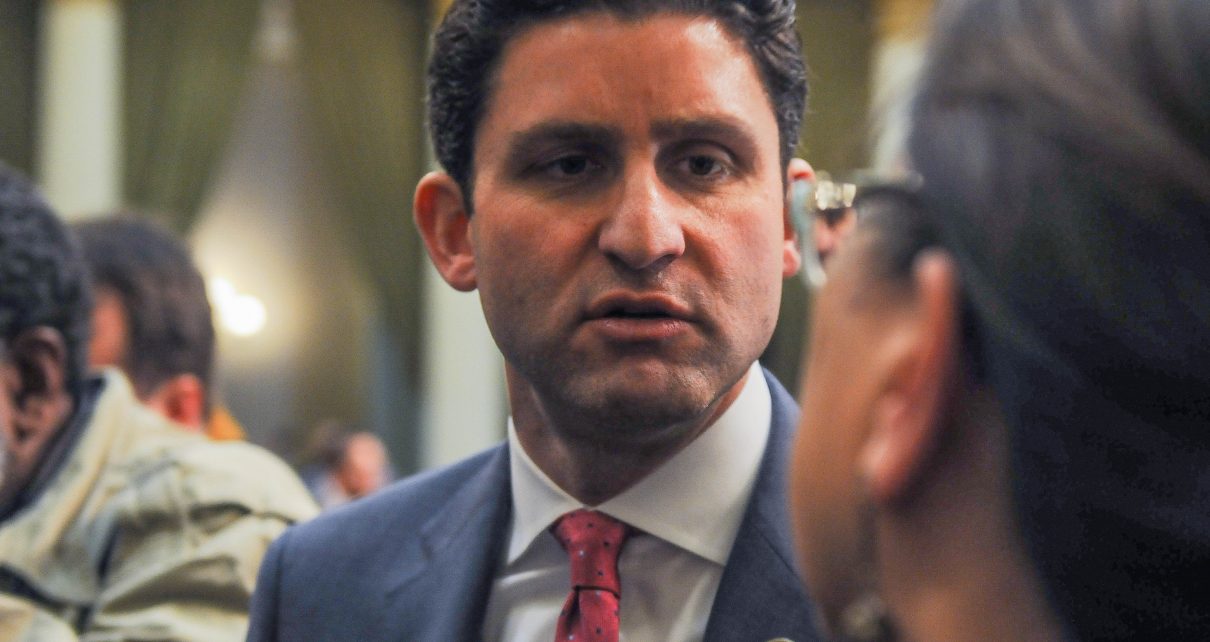
Assemblyman Jesse Gabriel. (Photo: Kevin Sanders for California Globe)
New Climate Change Disclosures Target ‘Commercial Development of Fossil Fuels’
AB 766 addresses the ‘social cost of carbon’
By Chris Micheli, March 20, 2021 8:36 am
On March 18, Assembly members Jesse Gabriel (D-Woodland Hills) and Steve Bennett (D-Santa Barbara) amended their Assembly Bill 766 dealing with corporate disclosures of climate change information. The bill would add Section 38537 to the Health and Safety Code.
The bill would define the following terms: “baseline scenario,” “carbon dioxide equivalent,” “climate change,” “commercial development of fossil fuels,” “covered corporation,” “direct greenhouse gas emissions,” “direct and indirect greenhouse gas emissions,” “domestic corporation,” “foreign corporation,” “fossil fuel reserves,” “greenhouse gas,” “greenhouse gas emissions,” “indirect greenhouse gas emissions,” “physical risks,” “social cost of carbon,” “transition risks,” “value chain,” and “well below 1.5 degrees scenario.”
“Climate change” would mean a change in climate that is attributed directly or indirectly to human activity that alters the composition of the global atmosphere and is in addition to natural climate variability observed over comparable time periods.
A “covered corporation” would mean a publicly traded domestic or foreign corporation whose principal executive offices, according to the corporation’s SEC 10-K form, are located in the state and whose annual revenues exceed $100,000,000.
The bill would specify that, on or before January 1, 2024, the California Air Resources Board (CARB), in consultation with the Secretary of State and the Treasurer, would be required to develop and adopt regulations that do all of the following:
- Beginning January 1, 2025, and annually thereafter, require a covered corporation to disclose to the CARB and the Secretary of State all of the following information for the prior calendar year:
- The potential financial impacts of, and any risk management strategies relating to, both of the following:
- The physical risks posed to the covered corporation by climate change.
- The transition risks posed to the covered corporation by climate change.
- A description of any corporate governance processes and structures established by the covered corporation to identify, assess, and manage climate-related risks.
- A description of specific actions that the covered corporation is taking to mitigate identified climate-related risks.
- A description of the resilience of the covered corporation’s strategy to address climate risks, taking into account different climate scenarios.
- A description of how climate risk is incorporated into the covered corporation’s overall risk management strategy.
In addition, the disclosures required would have to include any other information required to be disclosed by a covered corporation pursuant to the regulations adopted by CARB to implement this section. CARB would establish climate change-related risk disclosure guidance that would have to do all of the following:
- To the extent practicable, is specialized for industries within specific sectors of the economy as follows:
- The finance, insurance, transportation, electric power, mining, and nonrenewable sectors.
- Any other sector determined to be appropriate by CARB.
- Establish reporting standards for estimating and disclosing direct and indirect greenhouse gas emissions by a covered corporation that do both of the following:
- Separate, to the extent practicable, the total emissions of each specified greenhouse gas by the covered corporation.
- Include greenhouse gas emissions by the covered corporation during the period covered by the disclosure.
- Include reporting standards for disclosure of both of the following:
- The total amount of fossil fuel-related assets owned or managed by the covered corporation.
- The percentage of fossil fuel-related assets as a percentage of total assets owned or managed by the covered corporation.
- Establish a minimum social cost of carbon, which would be considered a minimum price with respect to costs associated with carbon emissions and be used by a covered corporation in preparing climate-related disclosure statements.
- Specify requirements for, and the disclosure of, input parameters, assumptions, and analytical choices to be used in climate scenario analyses required, including all of the following:
- Present value discount rates.
- Timeframes to consider, including 5-, 10-, and 20-year timeframes.
- The minimum pricing of greenhouse gas emissions.
- Include documentation standards and guidance with respect to information required.
In addition, the bill would require a covered corporation to incorporate into the covered corporation’s disclosure all of the following:
- A quantitative analysis to support any qualitative statement made by the covered corporation in its disclosure.
- Industry-specific metrics that correspond to the sectors identified.
- Specific risk management actions that the covered corporation is taking to address identified risks.
- A discussion of the short-, medium-, and long-term resilience of any risk management strategy, and the evaluation of applicable risk metrics, of the covered corporation.
- The total cost of carbon attributable to the direct and indirect greenhouse gas emissions of the covered corporation, using, at a minimum, the social cost of carbon.
- Any other information or climate change-related metric that CARB determines is necessary and appropriate to safeguard the public interest or directed at ensuring that investors are fully informed regarding the covered corporation’s climate-related risks.
Moreover, the bill would require a covered corporation, when preparing any qualitative or quantitative risk analysis statement contained in the covered corporation’s disclosure to consider all of the following:
- A baseline scenario that includes the physical impacts of climate change.
- A well below 1.5 degrees scenario.
- Any additional climate analysis scenario considered appropriate by CARB.
AB 766 would require a covered corporation, if it engages in the commercial development of fossil fuels, to include in the covered corporation’s disclosure all of the following:
- An estimate of the total and disaggregated amount of direct and indirect greenhouse gas emissions of the covered corporation that are attributable to any of the following:
- Combustion.
- Flared hydrocarbons.
- Process emissions.
- Fugitive emissions or leaks.
- Land use changes.
- A description of all of the following:
- The sensitivity of fossil fuel reserves levels to future price projection scenarios that incorporate the social cost of carbon into hydrocarbon pricing.
- The percentage of the reserves of the covered corporation that will be developed, as well as a forecast for the development prospects of each reserve.
- The potential amount of direct and indirect greenhouse gas emissions that are embedded in proved and probable hydrocarbon reserves, with each such calculation presented as a total and in subdivided categories by the type of reserve.
- The methodology of the covered corporation for detecting and mitigating fugitive methane emissions, which would have to include all of the following:
- The frequency with which applicable assets of the covered corporation are observed for methane leaks.
- The processes and technology that the covered corporation uses to detect methane leaks.
- The percentage of assets of the covered corporation that the covered corporation inspects under the methodology.
- The quantitative and timebound reduction goals of the covered corporation with respect to methane leaks.
- The amount of water that the covered corporation withdraws from freshwater sources for use and consumption in operations of the covered corporation.
- The percentage of the water that comes from regions of water stress or that face wastewater management challenges.
- Any other information that CARB determines is necessary and appropriate to safeguard the public interest or directed at ensuring that investors are fully informed regarding a covered corporation’s climate-related risks.
CARB would be authorized to adopt any other regulations it deems necessary to implement this section. It would have to comply with the rulemaking provisions of the Administrative Procedure Act.
On or before January 1, 2024, the Department of Finance, with guidance from the Treasurer and the California Debt and Investment Advisory Commission, would be required to develop climate change disclosure guidance, comparable to the regulations required to be adopted by CARB for issuers of state and local debt.
Finally, the bill contains a severability clause and it provides that, to the extent that any provision of this section is preempted by federal law, that provision, and any corresponding provision of the regulations adopted by CABR and the guidance developed by the Department of Finance pursuant to this section, do not apply and would not be enforced.
- Summons in California Civil Actions - July 7, 2025
- Family Conciliation Courts in California - July 6, 2025
- California Family Mediation and Conciliation Services - July 5, 2025








Deplorables
Yes…yes….finish every greedy producer off…..finish the economic desert…..perhaps, the remaining Mad Max survivors will be reclassified “endangered”, a protected, entitled, equal group….
Jeebus Criminy! How many bullet points are in this article???
Well, this shows that although the Bay Area Democrats are more prolific, this knucklehead Gabriel representing my old hometown are ALSO contributing to the California Corporate exodus, by saddling them with administrivia like this misguided attempt to save the world from their imagined “climate change” boogeyman…
Guess it’s too difficult to effect meaningful change in Communist China, where the REAL global threat to the environment emanates, while they sacrifice their citizens and the rest of the world to advance their economic global dominance agenda…
Silly Democrats… Being played for fools by their ChiCom overlords and benefactors…
And California voters allow their economic futures to be diminished by these legislators…
The solution becomes clearer by the day…
Wouldn’t publicly traded corporations be forced to leave California because of their fiduciary responsibility to their stock holders? This sounds ridiculously expensive and would reveal too much information competitors could exploit.
“The whole aim of practical politics is to keep the populace alarmed (and hence clamorous to be led to safety) by an endless series of hobgoblins, most of them imaginary.”
H.L. Mencken
There is no ‘climate change crisis’, no climate change national security threat, no reason to suppress the production and use of fossil fuels and no reason to invest in so-called ‘green energy’. The hypothesis that’s devolved into the CO2 anthropogenic global warming (CAGW) hoax is based on the flawed predictions of imprecise 1980’s vintage global circulation models that have failed to match observational data both since and prior to their fabrication. Additionally, water vapor is by far the dominant atmospheric ‘greenhouse’ gas, not CO2, and it’s atmospheric content is determined by the climate, not vice versa.
The earth’s climate is determined primarily by the radiation it receives from the sun. The amount of solar radiation the earth receives has natural variabilities caused by both variations in the intrinsic amount of radiation emitted by the sun and by variations in the earth-sun geometry caused by planetary rotational and orbital variations. Together these natural variations cause the Total Solar Irradiance (TSI) of the earth to vary cyclically on a number of known periodicities that are synchronized with known past climate changes.
@ACRIM, you could not have said it better. The climate change idiots want science facts? You just gave some good ones.